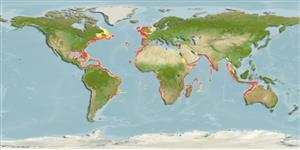Classification / Names
Common names from other countries
Issue
The spelling conchifera is considered as the correct one by some authors. To be verified.
Main reference
Size / Weight / Age
Max length : 80.0 cm TL male/unsexed; (Ref. 4253); common length : 50.0 cm TL male/unsexed; (Ref. 5217); max. published weight: 3.2 kg (Ref. 7251)
Environment
Marine; benthopelagic; depth range 50 - 600 m (Ref. 4968), usually 150 - 300 m (Ref. 36731)
Climate / Range
Deep-water, preferred 23°C (Ref. 107945); 58°N - 28°S
Distribution
Atlantic Western Indian Ocean: Somalia (Ref. 30573) and India to South Africa, but not in the Red Sea. Eastern Atlantic: Bay of Biscay to South Africa. Western Atlantic: Sable Island, Canada to northern North Carolina, USA (Ref. 7251) to northern Argentina (Ref. 27363). Reported from the Mediterranean (Ref. 93173). Reported from Indonesia (Ref. 5978) but not in the Pacific Ocean.
Countries | FAO areas | Ecosystems | Occurrences | Introductions
Short description
Dorsal
spines
(total): 9 - 10;
Dorsal
soft rays
(total): 24-26;
Anal
spines: 3;
Anal
soft rays: 24 - 26. Body silvery, with a dusky mid lateral spot just posterior to and slightly above end of pectoral fin (Ref. 4253). Fin membranes of spinous dorsal, pectoral, pelvic and caudal fins blackish (Ref. 27363).
IUCN Red List Status (Ref. 115185)
Threat to humans
Harmless
Human uses
Fisheries: commercial
Tools
Special reports
Download XML
Internet sources
Estimates of some properties based on models
Phylogenetic diversity index
PD50 = 0.5781 many relatives (e.g. carps) 0.5 - 2.0 few relatives (e.g. lungfishes)
Trophic Level
4.5 ±0.0 se; Based on diet studies.
Resilience
Low, minimum population doubling time 4.5 - 14 years (Assuming tm>4)
Vulnerability
High vulnerability (61 of 100)
Price category
